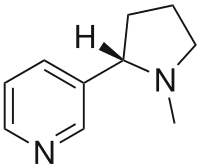
Photo from wikipedia
BackgroundAn estimated 2 million youth (in 2017) and 7.9 million adults (in 2015) reported currently using electronic nicotine delivery systems (ENDS). Reports of poisoning events related to liquid nicotine (e-liquids)… Click to show full abstract
BackgroundAn estimated 2 million youth (in 2017) and 7.9 million adults (in 2015) reported currently using electronic nicotine delivery systems (ENDS). Reports of poisoning events related to liquid nicotine (e-liquids) in ENDS have been on the rise, but current, nationally-representative estimates of hospital-treated poisoning cases related to e-liquid nicotine exposure in the United States (US) are lacking.FindingsWe used National Electronic Injury Surveillance System (NEISS) data from 2013 to 2017 to calculate national estimates with 95% confidence intervals (CIs) of poisoning incidents related to e-liquid nicotine exposure. From 2013 to 2017, an estimated 4745 poisoning cases related to e-liquids among children under age five were treated in US hospital emergency departments; the number of cases increased from 181 (95% CI: 0–369) in 2013 to 1736 (95% CI, 871–2602) in 2015 and then decreased to 411 (95% CI, 84–738) in 2017. Most of the cases were treated and released; 4.1% were admitted to the hospital. The most common route of exposure was through ingestion (96.9%), and 2.6% of the cases were through dermal exposure. The highest amounts of e-liquids or nicotine ingested were 118.2mL, 1 bottle, and 100 mg, and the most common symptoms (63.6%) related to nicotine poisoning were nausea and vomiting.ConclusionsThis study provides national estimates of poisoning cases associated with nicotine exposure from e-liquids among children under age five. Findings on e-liquid volume or nicotine dose, when available, provide important insights into exposures associated with toxicity in children. Since NEISS data do not include product codes specific to ENDS or provide information on poisoning severity, we used general keywords to capture these events, which might underestimate the population burden. Information from this study may complement efforts, such as public education, to prevent unintended exposure to nicotine in e-liquids among children.
Journal Title: Injury Epidemiology
Year Published: 2019
Link to full text (if available)
Share on Social Media: Sign Up to like & get
recommendations!